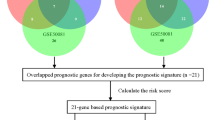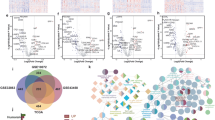Abstract
Background
Lung adenocarcinoma (LUAD) has become the most frequent histologic type of lung cancer in the past several decades. Recent successes with immune checkpoint blockade therapy have demonstrated that the manipulation of the immune system is a very potent treatment for LUAD. This study aims to explore the role of immune-related genes in the development of LUAD and establish a signature that can predict overall survival for LUAD patients.
Methods
To identify the differential expression genes (DEGs) between normal and tumor tissues, we developed an analysis strategy to combine an independent-sample design and a paired-sample design using RNA-seq transcriptomic profiling data of The Cancer Genome Atlas LUAD samples. Further, we selected prognostic markers from DEGs and evaluated their prognostic value in a prediction model.
Results
We identified and validated PD1, PDL1 and CTLA4 genes as prognostic markers, which are well-known immune checkpoints, and revealed two new potential prognostic immune checkpoints for LUAD, HHLA2 (logFC = 2.55, FDR = 1.89 × 10–6) and VTCN1 (logFC = −2.86, FDR = 1.72 × 10–11). Furthermore, we identified an 18-gene LUAD prognostic biomarker panel and observed that the classified high-risk group presented a significantly shorter overall survival time (HR = 3.57, p value = 4.07 × 10–10). The prediction model was validated in five independent high-throughput gene expression datasets.
Conclusions
The identified DEG features may serve as potential biomarkers for prognosis prediction of LUAD patients and immunotherapy. Based on that assumption, we identified a gene expression-based immune signature for lung adenocarcinoma prognosis.



Similar content being viewed by others
Abbreviations
- BH:
-
Benjamin and Hochberg
- CAMS:
-
Cell adhesion molecules
- DEG:
-
Differential expression genes
- DEIGs:
-
Differential expression immune genes
- FDR:
-
False discovery rate
- GEO:
-
Gene expression omnibus
- HR:
-
Hazard ratio
- IgA:
-
Immunoglobulin A
- KEGG:
-
Kyoto encyclopedia of genes and genomes
- LUAD:
-
Lung adenocarcinoma
- RPKM:
-
Reads per kilobase per million
- TCGA:
-
The Cancer Genome Atlas
References
Siegel RL, Miller KD, Jemal A (2019) Cancer statistics, 2019. Cancer J Clin 69:7–34. https://doi.org/10.3322/caac.21551
Institute. NC. SEER Cancer Statistics Review, 1975–2011. Available online: https://seer.cancer.gov/csr/1975_2011/
Zappa C, Mousa SA (2016) Non-small cell lung cancer: current treatment and future advances. Transl Lung Cancer Res 5:288–300. https://doi.org/10.21037/tlcr.2016.06.07
Saito M, Suzuki H, Kono K, Takenoshita S, Kohno T (2018) Treatment of lung adenocarcinoma by molecular-targeted therapy and immunotherapy. Surg Today 48:1–8. https://doi.org/10.1007/s00595-017-1497-7
Cha YJ, Kim HR, Lee CY, Cho BC, Shim HS (2016) Clinicopathological and prognostic significance of programmed cell death ligand-1 expression in lung adenocarcinoma and its relationship with p53 status. Lung cancer 97:73–80. https://doi.org/10.1016/j.lungcan.2016.05.001
Teglasi V, Reiniger L, Fabian K et al (2017) Evaluating the significance of density, localization, and PD-1/PD-L1 immunopositivity of mononuclear cells in the clinical course of lung adenocarcinoma patients with brain metastasis. Neuro-oncology 19:1058–1067. https://doi.org/10.1093/neuonc/now309
Pardoll DM (2012) The blockade of immune checkpoints in cancer immunotherapy. Nat Rev Cancer 12:252–264. https://doi.org/10.1038/nrc3239
de Mello RA, Veloso AF, Esrom Catarina P, Nadine S, Antoniou G (2017) Potential role of immunotherapy in advanced non-small-cell lung cancer. OncoTargets Therapy 10:21–30. https://doi.org/10.2147/OTT.S90459
Mahoney KM, Rennert PD, Freeman GJ (2015) Combination cancer immunotherapy and new immunomodulatory targets. Nat Rev Drug Discov 14:561–584. https://doi.org/10.1038/nrd4591
Rizvi NA, Mazieres J, Planchard D et al (2015) Activity and safety of nivolumab, an anti-PD-1 immune checkpoint inhibitor, for patients with advanced, refractory squamous non-small-cell lung cancer (CheckMate 063): a phase 2, single-arm trial. Lancet Oncol 16:257–265. https://doi.org/10.1016/S1470-2045(15)70054-9
Yamazaki N, Uhara H, Fukushima S et al (2015) Phase II study of the immune-checkpoint inhibitor ipilimumab plus dacarbazine in Japanese patients with previously untreated, unresectable or metastatic melanoma. Cancer Chemother Pharmacol 76:969–975. https://doi.org/10.1007/s00280-015-2870-0
Brahmer JR, Drake CG, Wollner I et al (2010) Phase I study of single-agent anti-programmed death-1 (MDX-1106) in refractory solid tumors: safety, clinical activity, pharmacodynamics, and immunologic correlates. J Clin Oncol Off J Am Soc Clin Oncol 28:3167–3175. https://doi.org/10.1200/JCO.2009.26.7609
Sharma P, Hu-Lieskovan S, Wargo JA, Ribas A (2017) Primary, adaptive, and acquired resistance to cancer immunotherapy. Cell 168:707–723. https://doi.org/10.1016/j.cell.2017.01.017
Lennerz V, Fatho M, Gentilini C, Frye RA, Lifke A, Ferel D, Wolfel C, Huber C, Wolfel T (2005) The response of autologous T cells to a human melanoma is dominated by mutated neoantigens. Proc Natl Acad Sci USA 102:16013–16018. https://doi.org/10.1073/pnas.0500090102
Matsushita H, Vesely MD, Koboldt DC et al (2012) Cancer exome analysis reveals a T-cell-dependent mechanism of cancer immunoediting. Nature 482:400–404. https://doi.org/10.1038/nature10755
Showe MK, Vachani A, Kossenkov AV et al (2009) Gene expression profiles in peripheral blood mononuclear cells can distinguish patients with non-small cell lung cancer from patients with nonmalignant lung disease. Can Res 69:9202–9210. https://doi.org/10.1158/0008-5472.CAN-09-1378
Kossenkov AV, Vachani A, Chang C et al (2011) Resection of non-small cell lung cancers reverses tumor-induced gene expression changes in the peripheral immune system. Clin Cancer Res Off J Am Assoc Cancer Res 17:5867–5877. https://doi.org/10.1158/1078-0432.CCR-11-0737
Robinson MD, McCarthy DJ, Smyth GK (2010) edgeR: a Bioconductor package for differential expression analysis of digital gene expression data. Bioinformatics 26:139–140. https://doi.org/10.1093/bioinformatics/btp616
Fehringer G, Liu G, Briollais L et al (2012) Comparison of pathway analysis approaches using lung cancer GWAS data sets. PLoS ONE 7:e31816. https://doi.org/10.1371/journal.pone.0031816
Cai G, **ao F, Cheng C, Li Y, Amos CI, Whitfield ML (2017) Population effect model identifies gene expression predictors of survival outcomes in lung adenocarcinoma for both Caucasian and Asian patients. PLoS ONE 12:e0175850. https://doi.org/10.1371/journal.pone.0175850
Topalian SL, Hodi FS, Brahmer JR et al (2012) Safety, activity, and immune correlates of anti-PD-1 antibody in cancer. N Engl J Med 366:2443–2454. https://doi.org/10.1056/NEJMoa1200690
Patel SP, Kurzrock R (2015) PD-L1 expression as a predictive biomarker in cancer immunotherapy. Mol Cancer Ther 14:847–856. https://doi.org/10.1158/1535-7163.MCT-14-0983
Xu H, Ma J, Wu J, Chen L, Sun F, Qu C, Zheng D, Xu S (2016) Gene expression profiling analysis of lung adenocarcinoma. Braz J Med Biol Res Revista brasileira de pesquisas medicas e biologicas. https://doi.org/10.1590/1414-431X20154861
Qian L, Luo Q, Zhao X, Huang J (2014) Pathways enrichment analysis for differentially expressed genes in squamous lung cancer. Pathol Oncol Res POR 20:197–202. https://doi.org/10.1007/s12253-013-9685-2
Dong ZY, Zhang C, Li YF et al (2018) Genetic and immune profiles of solid predominant lung adenocarcinoma reveal potential immunotherapeutic strategies. J Thorac Oncol Off Publ Int Assoc Study Lung Cancer 13:85–96. https://doi.org/10.1016/j.jtho.2017.10.020
Kadara H, Choi M, Zhang J et al (2017) Whole-exome sequencing and immune profiling of early-stage lung adenocarcinoma with fully annotated clinical follow-up. Ann Oncol Off J Eur Soc Med Oncol 28:75–82. https://doi.org/10.1093/annonc/mdw436
Yoon HS, Chen X, Yang VW (2003) Kruppel-like factor 4 mediates p53-dependent G1/S cell cycle arrest in response to DNA damage. J Biol Chem 278:2101–2105. https://doi.org/10.1074/jbc.M211027200
Behbakht K, Qamar L, Aldridge CS, Coletta RD, Davidson SA, Thorburn A, Ford HL (2007) Six1 overexpression in ovarian carcinoma causes resistance to TRAIL-mediated apoptosis and is associated with poor survival. Can Res 67:3036–3042. https://doi.org/10.1158/0008-5472.CAN-06-3755
Reichenberger KJ, Coletta RD, Schulte AP, Varella-Garcia M, Ford HL (2005) Gene amplification is a mechanism of Six1 overexpression in breast cancer. Can Res 65:2668–2675. https://doi.org/10.1158/0008-5472.CAN-04-4286
Fu Y, Yan W, Mohun TJ, Evans SM (1998) Vertebrate tinman homologues XNkx2-3 and XNkx2-5 are required for heart formation in a functionally redundant manner. Development 125:4439–4449
Stohr N, Kohn M, Lederer M, Glass M, Reinke C, Singer RH, Huttelmaier S (2012) IGF2BP1 promotes cell migration by regulating MK5 and PTEN signaling. Genes Dev 26:176–189. https://doi.org/10.1101/gad.177642.111
Stokes A, Wakano C, Koblan-Huberson M, Adra CN, Fleig A, Turner H (2006) TRPA1 is a substrate for de-ubiquitination by the tumor suppressor CYLD. Cell Signal 18:1584–1594. https://doi.org/10.1016/j.cellsig.2005.12.009
Blanco I, Kuchenbaecker K, Cuadras D et al (2015) Assessing associations between the AURKA-HMMR-TPX2-TUBG1 functional module and breast cancer risk in BRCA1/2 mutation carriers. PLoS ONE 10:e0120020. https://doi.org/10.1371/journal.pone.0120020
De Craene B, Berx G (2013) Regulatory networks defining EMT during cancer initiation and progression. Nat Rev Cancer 13:97–110. https://doi.org/10.1038/nrc3447
Barker HE, Cox TR, Erler JT (2012) The rationale for targeting the LOX family in cancer. Nat Rev Cancer 12:540–552. https://doi.org/10.1038/nrc3319
Raulet DH (2003) Roles of the NKG2D immunoreceptor and its ligands. Nat Rev Immunol 3:781–790. https://doi.org/10.1038/nri1199
**ao Y, Freeman GJ (2015) A New B7:CD28 family checkpoint target for cancer immunotherapy: HHLA2. Clin Cancer Res Off J Am Assoc Cancer Res 21:2201–2203. https://doi.org/10.1158/1078-0432.CCR-14-2658
Zhao R, Chinai JM, Buhl S et al (2013) HHLA2 is a member of the B7 family and inhibits human CD4 and CD8 T-cell function. Proc Natl Acad Sci USA 110:9879–9884. https://doi.org/10.1073/pnas.1303524110
Cheng H, Janakiram M, Borczuk A et al (2017) HHLA2, a new immune checkpoint member of the B7 family, is widely expressed in human lung cancer and associated with EGFR Mutational Status. Clin Cancer Res Off J Am Assoc Cancer Res 23:825–832. https://doi.org/10.1158/1078-0432.CCR-15-3071
Prasad DV, Richards S, Mai XM, Dong C (2003) B7S1, a novel B7 family member that negatively regulates T cell activation. Immunity 18:863–873. https://doi.org/10.1016/s1074-7613(03)00147-x
Chen C, Zhu YB, Shen Y, Zhu YH, Zhang XG, Huang JA (2012) Increase of circulating B7–H4-expressing CD68+ macrophage correlated with clinical stage of lung carcinomas. J Immunother 35:354–358. https://doi.org/10.1097/CJI.0b013e31824212c4
Zhang X, Cai L, Zhang G, Shen Y, Huang J (2017) B7–H4 promotes tumor growth and metastatic progression in lung cancer by impacting cell proliferation and survival. Oncotarget 8:18861–18871. https://doi.org/10.18632/oncotarget.14475
Chen C, Qu QX, Shen Y, Mu CY, Zhu YB, Zhang XG, Huang JA (2012) Induced expression of B7–H4 on the surface of lung cancer cell by the tumor-associated macrophages: a potential mechanism of immune escape. Cancer Lett 317:99–105. https://doi.org/10.1016/j.canlet.2011.11.017
Lin WW, Karin M (2007) A cytokine-mediated link between innate immunity, inflammation, and cancer. J Clin Investig 117:1175–1183. https://doi.org/10.1172/JCI31537
Coussens LM, Werb Z (2002) Inflammation and cancer. Nature 420:860–867. https://doi.org/10.1038/nature01322
Acknowledgements
We thank the study participants and research staff for their contributions and commitment to this study.
Funding
The preparation of this manuscript was supported by internal funding from the University of South Carolina for Dr. Feifei **ao and Dr. Guoshuai Cai.
Author information
Authors and Affiliations
Contributions
FX and GC made substantial contributions to the conception and design of the study. LW and XL performed all analyses. All authors made substantial contributions to the acquisition, analysis or interpretation of data for the work. LW wrote the first draft of the manuscript. FX, GC, CC and CIA revised the manuscript for important intellectual content. All authors approved the manuscript.
Corresponding author
Ethics declarations
Conflict of interest
No potential conflicts of interest were disclosed.
Additional information
Publisher's Note
Springer Nature remains neutral with regard to jurisdictional claims in published maps and institutional affiliations.
Electronic supplementary material
Below is the link to the electronic supplementary material.
Rights and permissions
About this article
Cite this article
Wang, L., Luo, X., Cheng, C. et al. A gene expression-based immune signature for lung adenocarcinoma prognosis. Cancer Immunol Immunother 69, 1881–1890 (2020). https://doi.org/10.1007/s00262-020-02595-8
Received:
Accepted:
Published:
Issue Date:
DOI: https://doi.org/10.1007/s00262-020-02595-8




